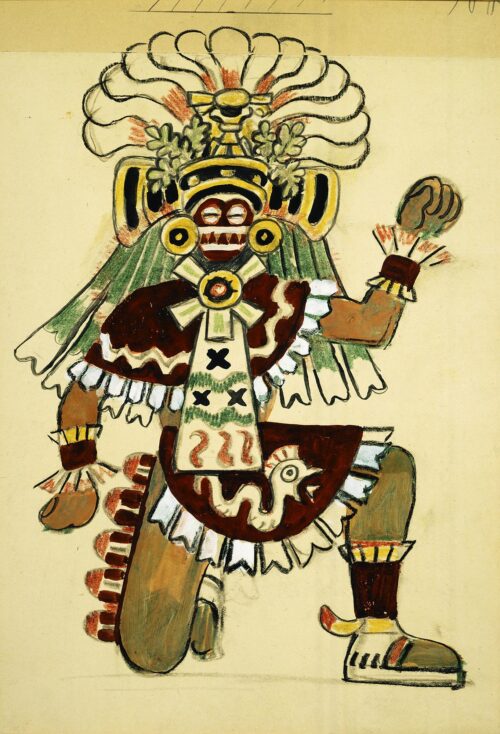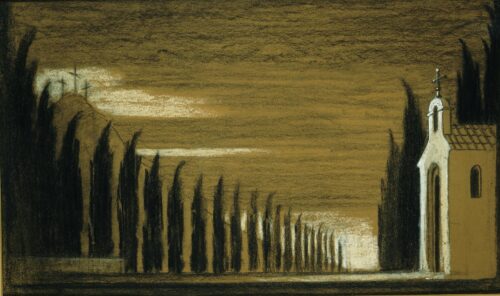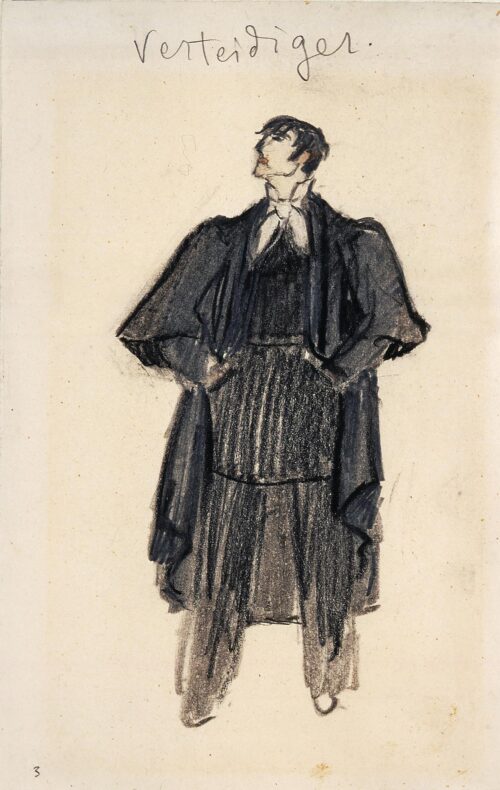
Aravadinos Panos (1886 - 1930)
“Zifir Faler”. Program Cover for the Musical in Three Acts by Nikolaos Laskaris, George Pop etc., 1916
At a very early age he showed an inclination for painting as well as a love of the theater. He began his studies by taking night lessons in painting at the National Technical University and then continued at the Royal Academy of Fine Arts in Berlin, later going to Paris. In 1910 his work “The Adoration of the Mag”, won the prize in the competition of the Berlin and Munich Academies.
The Balkan wars obliged him to return to Greece where he fought as a reserve. During this period he designed all the uniforms for the Greek Army and made a series of works concerned with his war experiences.
His first contact with set design is dated to 1914 when he made the sets for the work Living Images presented by the Amateurs Society.During the following two years he designed and supervised the construction of the sets and costumes for operettas and plays. His greatest successes were the works he did for the Xifir Faler Revue. But he never stopped painting and indeed painted the portraits of some of the eminent figures of the time.
In 1918 he was hired by the Royal Theater of Berlin and the same year was appointed to the State Opera of Berlin. During his frequent trips to Paris he cultivated a friendship with Dimitris Galanis who acted as a go-between for the publication of his cartoons in French periodicals.
His first major success in Germany was scored in 1920 with the sets for the opera of Richard Strauss “Die Frau Ohne Statten”. In 1912 he won the prize of the State Patent Office for his architectural design for the state theater and concert halls. In 1926 he was awarded the title of artistic advisor to German theaters and to him was assigned the organization of his own school of design operating in the studios of the Berlin State Opera. His activities also extended to the theaters of other German towns.
In 1927 he was called to Athens to offer advice in regard to the renovation of the stage of the Municipal Theater and a while later for the renovation of the Royal Theater. In 1930 he was summoned to Paris where he died.

“Zifir Faler”. Program Cover for the Musical in Three Acts by Nikolaos Laskaris, George Pop etc., 1916

“The Irruption of the Pigeons”, 1930

“Mexican God”, 1930

“Mexican God”, 1930

Study of Hands

“Saint James Carrying the Columns of Heracles”, 1930

“The Place where Columbus and Isabella Meet”, 1930

“Arrival in America”, 1930

“The Mutiny of the Crew”, 1930

“Columbus and his Men”, 1930

Portrait of Zafeiris Matsas

Portrait of Nina Efkeidi, 1922 - 1924

Children in Courtyard

Portrait of Ioannis Valaoritιs, first half of 20th century

“The Inn”, for the 1st Act of the Opera by Franz Schreker “The Treasure Seeker”, 1921

“The Advocate”, 1930

“The Prosecutor”, 1930

“Columbus in the Hold of the Ship”, 1930

“The Narrator”, 1930

“The New Continent”, 1930

The Π-Shaped Front Stage with the Narrator’s Pulpit, the Procession of the Lancers, the Banners of Castile and Aragon and the Chorus in the Backstage”, 1930

“Scene of the Mutiny”, 1930

“The Prosecutor” (Variation), 1930

“Mexican God”, 1930

We use cookies to make our site work properly, to personalize content and ads, to provide social media features and to analyze our traffic. We also share information about how you use our site with our social media, advertising and analytics partners. Read the Cookies Policy.
These cookies are necessary for the website to function and cannot be switched off in our systems. They are usually only set in response to actions made by you which amount to a request for services, such as setting your privacy preferences, logging in or filling in forms. You can set your browser to block or alert you about these cookies, but some parts of the site will not then work. These cookies do not store any personally identifiable information.
If you disable this cookie, we will not be able to save your preferences. This means that every time you visit this website you will need to enable or disable cookies again.
These cookies tell us about how you use the site and they help us to make it better. For example these cookies count the number of visitors to our website and see how visitors move around when they are using it. This helps us to improve the way our site works, for example, by ensuring that users find what they are looking for easily. Our website uses Google Analytics for statistics reporting.
Please enable Strictly Necessary Cookies first so that we can save your preferences!